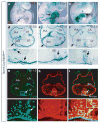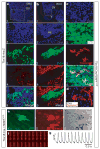A myocardial lineage derives from Tbx18 epicardial cells
- PMID: 18480752
- PMCID: PMC5540369
- DOI: 10.1038/nature06969
A myocardial lineage derives from Tbx18 epicardial cells
Abstract
Understanding the origins and roles of cardiac progenitor cells is important for elucidating the pathogenesis of congenital and acquired heart diseases. Moreover, manipulation of cardiac myocyte progenitors has potential for cell-based repair strategies for various myocardial disorders. Here we report the identification in mouse of a previously unknown cardiac myocyte lineage that derives from the proepicardial organ. These progenitor cells, which express the T-box transcription factor Tbx18, migrate onto the outer cardiac surface to form the epicardium, and then make a substantial contribution to myocytes in the ventricular septum and the atrial and ventricular walls. Tbx18-expressing cardiac progenitors also give rise to cardiac fibroblasts and coronary smooth muscle cells. The pluripotency of Tbx18 proepicardial cells provides a theoretical framework for applying these progenitors to effect cardiac repair and regeneration.
Figures




Comment in
-
Tbx18 and the fate of epicardial progenitors.Nature. 2009 Apr 16;458(7240):E8-9; discussion E9-10. doi: 10.1038/nature07916. Nature. 2009. PMID: 19369973
References
-
- Olson EN. A decade of discoveries in cardiac biology. Nature Med. 2004;10:467–474. - PubMed
-
- Srivastava D. Making or breaking the heart: from lineage determination to morphogenesis. Cell. 2006;126:1037–1048. - PubMed
-
- Murry CE, Field LJ, Menasche P. Cell-based cardiac repair: reflections at the 10-year point. Circulation. 2005;112:3174–3183. - PubMed
-
- Buckingham M, Meilhac S, Zaffran S. Building the mammalian heart from two sources of myocardial cells. Nature Rev Genet. 2005;6:826–835. - PubMed
Publication types
MeSH terms
Substances
Grants and funding
LinkOut - more resources
Full Text Sources
Other Literature Sources
Medical
Molecular Biology Databases
Research Materials

